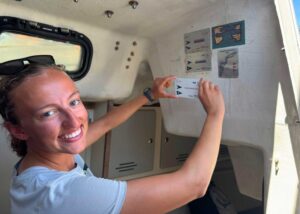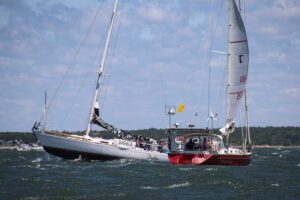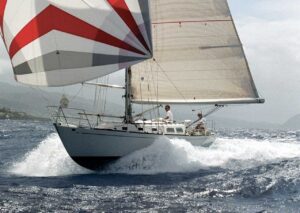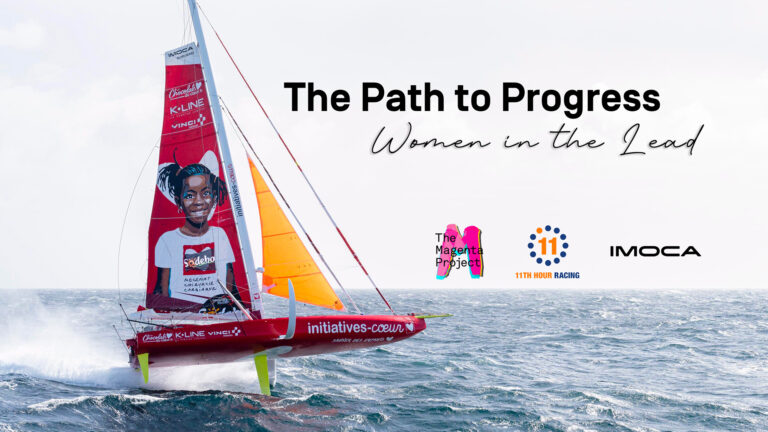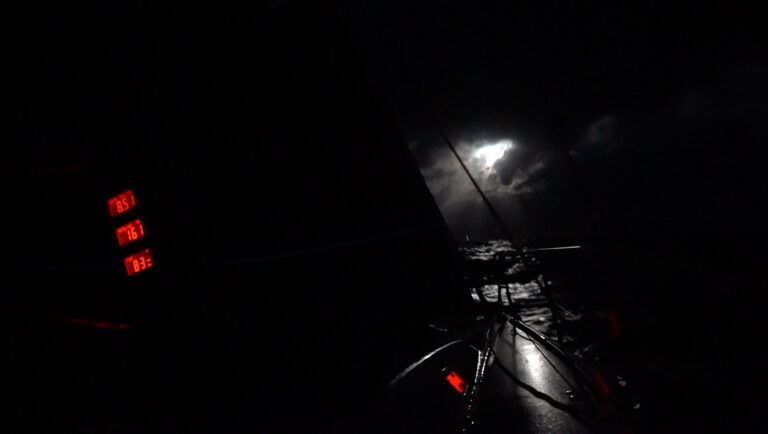If you’ve ever been caught out Laser sailing in a serious squall, you have a taste of what it’s like to be completely self-sufficient in an over-canvassed boat, with the safety net of land feeling like an untrustworthy mirage. Now imagine that you’re alone in the middle of the North Atlantic, with land nothing more than a week-old memory, on a wildly powerful IMOCA Open 60. Now you’re starting to get a feel for the life of Loick Peyron, the only man to have won an historic three Transat races.
I caught up with Loick in Boston Harbor, a few days after his trifecta, and joined him for an afternoon of sailing aboard Gitana Eighty, the Farr-designed steed of which Peyron is the skipper. The winds were blowing a moderate 12-15 knots out of the northeast, and the seas were flat. Still, Boston Harbor and the fairway leading out to the open waters beyond the Boston Harbor Islands are hectic. Lobster pots punctuate the otherwise watery canvas, and commercial vessels—many of them in the supertanker category—regularly transit this working waterfront. And that’s not to speak of the myriad pleasure boats, ferries, and sailboats that also occupy these waters. So, while these conditions were mere child’s play for a man tough enough to win three Transats, they had their own challenges. An Open 60 is designed to make tracks over wide-open expanses. It is hardly suited to close-quarters piloting.
Couple these obstacles with the fact that we were sailing along at 13 knots under a reefed mainsail and a Solent, and you begin to see that Peyron had a lot of balls up in the air. He also had three journalists aboard, ready to capture the moment. Yet, throughout, he was the model of calm, cool, and collected. True, he had three of his shore crew aboard, but given the massive amount of sail area in play, the miles of cordage (I swear, Gitana Eighty has tweakers for its tweakers), and given the spooky loads involved and a not-so-cheap price tag on the boat, most sailors would opt for that squally Laser ride over the responsibility that hung squarely upon this skipper’s shoulders.
But instead of stress or even detectable concentration lines on his brow, there was nothing but elation and calm on his face and in his persona as he casually floated from position to position: a little ease here, a bit of a trim there, occasionally pausing to christen another cigarette, which he daintily smoked through a cigarette holder. Tied to the stern lifelines were two Buddhist Prayer flags (the horse, for any practitioners out there). When queried about the flags, Peyron responded, “I like the spirit of Buddhism. Plus, they can’t be bad luck.”
Apparently not, given his track record.
Looking closer, it became absolutely clear that Loick Peyron is the master of his floating home, intimately knowing every nook, cranny, sheet, and line. He has to; there simply isn’t an alternative when conditions grow sloppy at 0200, and you’re the only guy aboard. Exhausted. Cold. Maybe even scared.
Belowdecks, Loick showed off his innovative living quarters-cum-nav station. In the center of the main cabin (nothing more than a white-painted carbon-fiber shell) is a pole, which serves as a pivot. Attached to this pivot is his nav station, which extends out to a rectangular cot, which also contains all of his food, clothing, and gear. Directly aft of this unit is a wide U-shaped track (similar to a traveler track used by some Open 60’s). By simply turning the grinding pedestal in the cockpit, Peyron can swing his living quarters, his nav station, and his provisions from side to side, allowing him to keep as much weight to weather as possible.
“In the Vendee Globe, I will have a few hundred kilograms of food aboard, so stacking this to weather helps me sail faster,” the Frenchman explains, his accent thick but his English perfect. So perfect in fact that he was joking earlier with one of the other journalists (a Brit) that one of his favorite classical-music composers is English—said of course solely for her benefit, but demonstrating a cultural knowledge and sympathy that you’ll find in few world-class athletes. One-dimensional he is not; but rather inquisitive and spellbound by life, culture, and music.
This harmonic thread of music flowed throughout our afternoon as Peyron hovered about, a small tune never more than a few seconds of downtime from his conversation. Confident is an easy word to throw out there, but it’s an understatement. Having spent time around Tibetean monks in the Himalaya, I was struck that the stuff that Loick possesses is closer to the stuff of those quiet, saffron-robbed men than to the ego one might expect of a sailing superstar. No bravado, just ease and comfort in his own skin.
“Loick, tonight is the prize-giving ceremony. What are you doing tomorrow?” I ask, expecting to hear of plans to visit New York City, or maybe even a trip to Newport.
“I’m going sailing,” he replied. “Back to France.”
“Alone? Already?”
“Yes. I need to get in more miles before the Vendee Globe starts this fall. I need to learn how to sail this boat better, to know it better than I do.”
And with this I couldn’t help but wonder if Peyron might not simply keep sailing after the Vendee instead of crossing the finishing line. It wouldn’t be the first time that a French master of the mind and the sea has done something of the sort, and while I never had the fortune to meet Bernard Moitessier, I couldn’t help imagining a kinship. For these men, the boat provides a path to a greater sense of being; the race is an opportunity to delve deeper into the mind.
Posted: May 30, 2008

